by BOB GLEASON
The daysailing trimaran market has grown tremendously in the last few years. This is largely because the three-hull platform certainly makes more sense for the way many people want to sail.
Compared to either a monohull or a catamaran, a trimaran is amazingly stable. This can be attributed to its length to beam ratio. Compared to other small boats, a trimaran will heel less and have more deck space. There are some trimarans that are as beamy as they are long and, of course there are trade-offs to consider. The added beam does add more stability and deck space, but how much is too much? The added beam does add weight, and may make a boat less maneuverable. The stability makes for a less athletic boat to sail, which allows for lounging around comfortably. Additionally, there is no need for a trapeze wire or hiking off the rail. Here is a very brief explanation of each of the small trimarans handled by The Multihull Source in Wareham, MA.
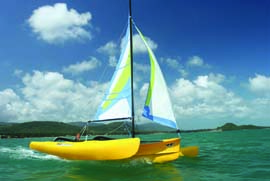
© WindRider.com
WindRider 17
WindRider trimarans have been around since 1996. They are great recreational boats that are extremely durable, thanks to the rotomolded polyethylene construction. They are a little unusual to sail in that all the models have helm seats facing forward and you steer with foot pedals. The WindRider 17 is perhaps the most versatile in that it can take more weight and therefore more people, and it has a rotating rig with both main and roller furling jib. It is hard to hurt a boat that is almost impossible to capsize and can be sailed in knee-deep water. The smaller Tango (W10) and original WindRider 16 have simple freestanding masts with only a mainsail. Visit WindRider.com.
Weta 4.4
Perhaps the fastest growing class of trimarans is the Weta 4.4 (14’ 5”). The first ever Weta National Championships was held in Ft. Walton Beach, FL in March 2013 and it attracted a fleet of 16 boats. This class is great fun! The Weta sports all-carbon components (mast, beams, sprit, daggerboard, rudder and rudderhead; the rig is boomless) and a sail plan that is powerful yet easy to manage. The nylon reacher is roller furling and the jib and main are fully battened. At 220 pounds all up, this is an easy boat to rig and push around the beach singlehanded. The Weta was originally designed as a kids’ training boat but is now mostly used as a single or doublehanded daysailer. Wetas are primarily raced singlehanded, but the winning boat at this year’s Nationals was doublehanded. Visit WetaMarine.com.
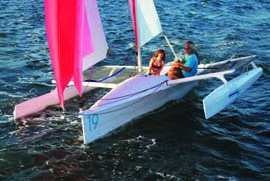
© Peter McGowan
SeaRail 19
New for 2014 is the SeaRail 19. Designed by Nigel Irens, it’s a pretty, graceful, daysailer that has enough room in the cabin that you could sleep there, although the space will be primarily used for sails and gear for either trailering or in-water storage. The cabin can be locked to keep gear safe. This boat is fun for singlehanding or with a group of three or four. The tiller is in front of the mainsheet and traveler, and the roller furling jib is self-tacking. This combination makes the SeaRail 19 a pleasure for relaxed sailing, and to it’s very easy to sail because you can tack and jibe without touching the sheets. The roller furling reacher adds the power many will like for screaming reaches. Visit SeaRail19.com.
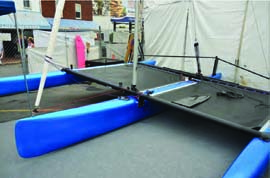
© smalltrimarans.com
UltraLight 20
The UltraLight 20 from Warren Light Craft is pure sailing joy! Lightweight, state-of-the-art construction combined with a modern design allows for a fast yet stable ride. Each boat is built to order, allowing you to create a boat tailored to your preferences. The UltraLight 20 comes completely apart in minutes and can be car-topped or trailered. This boat is the brainchild of Ted Warren, who has made a name for himself in both kayaks and performance trimarans. VisitWarrenLightCraft.com.
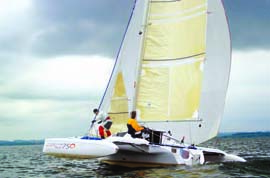
© CorsairMarine.com
Corsair 750
The Corsair 750 comes in both a daysailer version called the SPRINT and a cabin cruiser version called the DASH. These 750s (7.5 meters; 24’ 5” LOA) are a recent update from the earlier Corsair 24s. The added mast height and higher volume floats have made this a rocketship for a boat its size. The 750 rates closer to the Corsair 28 than either the Corsair 27 or 24. It is so much faster than the earlier 24s that it owes them over a minute a mile on the racecourse! As with all Corsair boats, the 750s are easy to trailer and easy to launch. Visit CorsairMarine.com.
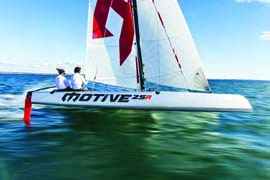
© MotiveTrimarans.com
Motive 25R
Of all the smaller trimarans on the market today, the Motive 25R is truly a unique daysailer that can go much faster than the wind while seating a bunch of friends comfortably. If you have the money to spend on the latest, greatest, sexiest, all-carbon rocketship, the Motive 25R has to be considered. It may not be quite as quick at the launching ramp (the boat is actually easy to trailer and launch, but with only one built to date the systems are not refined yet), but on the water…watch out! Visit MotiveTrimarans.com.
Bob Gleason is the President of The Multihull Source in Wareham, MA. For more information, visit themultihullsource.com.
